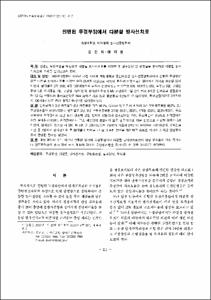KUMEL Repository
1. Journal Papers (연구논문)
1. School of Medicine (의과대학)
Dept. of Radiation Oncology (방사선종양학)
진행된 두경부암에서 다분할 방사선치료
- Keimyung Author(s)
- Kim, Jin Hee
- Department
- Dept. of Radiation Oncology (방사선종양학)
- Journal Title
- Radiation Oncology Journal
- Issued Date
- 2003
- Volume
- 21
- Issue
- 2
- Abstract
- Purpose: The effects of hypefractionation radiation therapy, such as the failure pattern and survival, on the treatment results in advanced stage head and neck cancer were studied.
Materials and Methods: Between September 1990 and October 1998, 24 patients with advanced stage (III, IV) head and neck cancers, were treated using hyperfractionation radiation therapy in the Department of Radiation Oncology at the Keimyung University Dongsan Medical Center. The male to female ratio was 7 : 1, and the age range from 38 to 71 years with the median of 56 years. With regard to the TNM stage, 11 patients were stage III and 13 were stage IV. The sites of primary cancer were the nasopharynx in six, the hypopharynx in 6, the larynx in five, the oropharynx in three, the maxillary sinus in three, and the oral cavity in one patient. The radiotherapy was delivered by 6 MV X-ray, with a fraction size of 1.2 Gy at two fractions a day, with at least 6 hours inter-fractional interval. The mean total radiation doses was 72 Gy, (ranging from 64.4 to 75.8 Gy). Follow-up periods ranged between 3 and 136 months, with the median of 52 months.
Results: The overall survival rates at 3 and 5 years in all patients were 66.7%, and 52.4%. The disease-free survival rates at 3 and S years (3YDFS, 5YDFS) in all patients were 66.7% and 47.6%. The 3YDFS and 5YDFS in stage III patients were 81.8% and 63.6%, and those in stage IV patients were 53.8% and 32.3%. Ten patients were alive with no local nor distant failures at the time of analyses. Six patients (25%) died due to distant metastasis and 12.5% died due to local failure. Distant metastasis was the major cause of failure, but 2 patients died due to unknown failures and 3 of other diseases. The distant metastasis sites were the lung (3 patients), the bone (1 patient), and the liver (2 patients). One patient died of second esophageal cancer. There were no severe late complications, with the exception of 1 osteo-radionecrosis of the mandible 58 months after treatment.
Conclusion: Although this study was peformed on small patients group, we considered hypefractionated radiation therapy for the treatment of advanced stage head and neck cancer might improve the disease free survival and decrease the local failure with no increase in late complications despite of the slight Increase in acute complications.
Key word : Head and neck cancer, Hyperfractionation, Radiation, Disease free survival, Failure, Complication
목적: 진행된 두경부암을 대상으로 다분할 방사선치료를 시행한 후 실패양상 및 생존율을 분석하고 다분할 방사선치료의 효과를 알아보고자 한다.
대상 및 방법: 1990년 9월부터 1995년 10월 사이에 계명대학교 동산의료원 방사선종양학과에서 진행된 두경부암으로 다분할 방사선치료를 시행한 환자 24명을 대상으로 하였다. 환자의 연령분포는 38세에서 71세로 중앙값 55세이었다. 병기별로 3기 11명, 4기 13명이었으며 남자가 21명이었고 비인두암 6명, 하인두암 6명, 후두암 5명, 구강인두암 3명, 부비동암 3명, 구강암 1명이었다. 방사선치료는 6 MV x-선으로 1일 2회, 최소 6시간 간격으로 분할조사량 1.2 Gy 시행하여 총치료선량은 64.4 Gy에서 76.8 Gy로 평균총방사선량은 72 Gy이었다. 추적관찰기간은 3개월에서 136개월이었고 중간 추적관찰기간은 52개월이었다.
결과: 전체환자의 3년 생존율과 5년 생존율은 각각 66.7%, 52.4%이었고 전체 환자의 3년 무병생존율은 66.7%, 5년 무병생존율은 47.6%이었다. 병기별로 3년, 5년 무병생존율은 3기는 81.8%, 63.6%, 4기는 53.8%, 32.3%이었다. 국소재발이나 원격전이의 소견 없이 생존해 있는 환자가 10명이며 원격전이는 25%, 국소재발은 12.5%로 원격전이가 주된 실패원인이었다. 원격전이인지 국소 재발인지 분명하지 않은 경우가 2명, 다른 원인으로 사망한 경우가 3명이었다. 원격전이 장소는 폐 3명, 뼈 1명, 간 2명이었으며 1명에서 식도에 2차암이 발생하여 사망하였다. 추적관찰 기간 중 1명에서 방사선치료 후 58개월에 하악골괴사로 수술한 경우를 제외하고 중등도 이상의 심각한 만성부작용이 발생한 환자는 없었다. 결론: 대상 환자의 수는 적으나 진행된 병기의 두경부암에서 다분할 방사선치료법이 급성 부작용은 다소 증가하나 만기부작용의 증가 없이 국소 재발의 감소와 무병생존율을 증가시킬 수 있을 것이라고 생각한다.
핵심용어 : 두경부암, 다분할 방사선치료, 무병생존율, 실패양상, 부작용
- Alternative Title
- Hyperfractionation Radiation Therapy in Advanced Head and Neck Cancer
- Keimyung Author(s)(Kor)
- 김진희
- Publisher
- School of Medicine
- Citation
- 김진희 and 예지원. (2003). 진행된 두경부암에서 다분할 방사선치료. Radiation Oncology Journal, 21(2), 112–117.
- Type
- Article
- ISSN
- 2234-1900
- Appears in Collections:
- 1. School of Medicine (의과대학) > Dept. of Radiation Oncology (방사선종양학)
- 파일 목록
-
-
Download
 oak-bbb-1078.pdf
기타 데이터 / 411.84 kB / Adobe PDF
oak-bbb-1078.pdf
기타 데이터 / 411.84 kB / Adobe PDF
-
Items in Repository are protected by copyright, with all rights reserved, unless otherwise indicated.